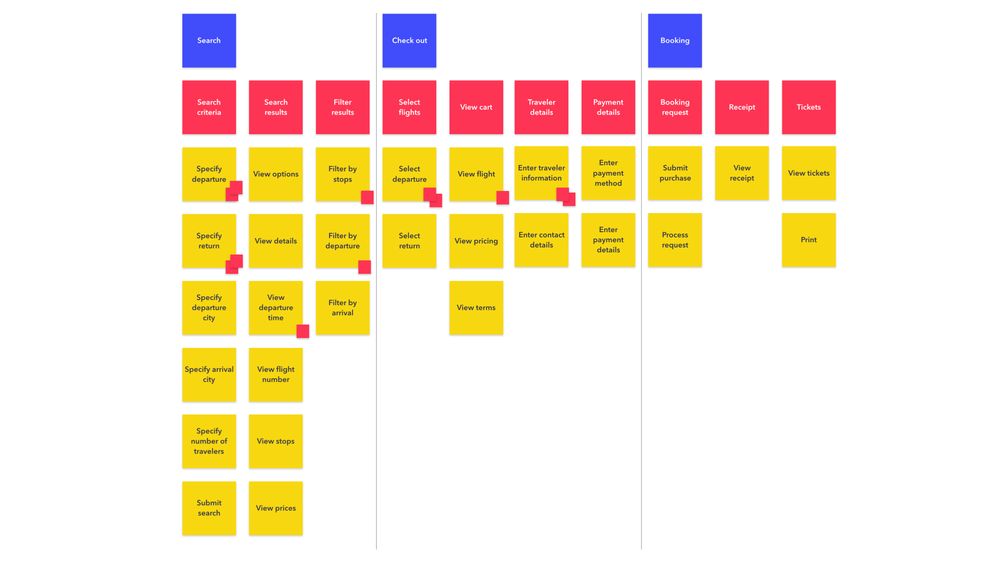Set priorities
During the workshop, the client team often takes a break after the story-mapping session. It’s not a bad idea to reorganize the working space and clean up the story map. Take pictures for posterity, capture any notes, and rewrite all the stories using legible handwriting. Then, place all the stories back up on the wall for prioritization.
At this point, it’s time to move from divergent thinking to convergent thinking. Start by defining release goals focusing on what outcomes to prioritize first.
For example, these were our goals when we created an airline ticket booking app:
- V1: Be able to book a ticket
- V2: Improve searching
- V3: Enhance the user experience
Focus the release goals so that they solve the business problems identified at the beginning of the workshop.
Doing research
Every project is different. Some pursuits warrant additional research beyond the workshop—preferably taking place before the workshop. For example, when tasked with creating a destination app for a resort client, the team visited one of their facilities to observe the check-in experience from both the customer and employee points of view.
Use data collected in the field as a reference point for the story map. Knowing all contributors are biased, work to minimize the bias to maximize the return on investment. For example, a stakeholder may stress the importance of chat functionality in the application, but field studies have indicated that customers actually prefer to self-service and only fall back on chat when other avenues fail.
Limiting influence
Given the opportunity, stakeholders try to prioritize everything—architecting a solution that becomes too complex and is financially hard to justify. To focus people and truly distill what is valuable, hand out a limited number of colored “priority” stickies. This should be done strategically, however. For larger groups, only give stickies to primary stakeholders, and limit them to three per person. Provide smaller groups more stickies to account for the smaller number of attendees.

When introducing the prioritization exercise to the team, explain that it’s best for all stories to fall into one of the following four categories:
- What you need now.
- What you need soon.
- What you need later.
- What is nice to have.
Have the stakeholders explain their choices while applying the stickies to the story map. Take and weight votes to determine what to prioritize and when. There are no written rules for this exercise, but avoid having all stories labeled as a “now” priority. This may indicate that the team did not expand discovery enough.
With release goals priorities in place, walk through the story map and identify which items support which release goals. Color-code the epics, features, and stories according to those goals, and identify any ideas that might need to be added to the story map to complete the release goal. Once the story map has been prioritized, start discussing risks and success metrics.
Defining what’s out of scope
Write up a separate list of items that are mutually agreed upon as out of scope for the foreseeable roadmap. While these items may not fall into MVP or MMP releases, they may still be viable roadmap items to explore for the product’s future.
Preestimating
At this point, significant trust has been built with the group of stakeholders. Consider running a Lean estimation exercise with the whole team around the defined epics. This is an excellent opportunity to revisit product funding.
By asking questions and throwing numbers around, the team starts to develop a clear understanding of the budget constraints and targets. Remember—always work with a number in mind; either align the product features with the number or help the sponsor align the number to the features through proof of ROI. Estimates are meant to serve as guideposts toward the outcomes that the business needs.